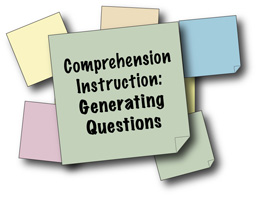What should content-area teachers know about comprehension instruction?
Page 13: Generating Questions

One way for students to increase their reading comprehension is by generating questions about the information they encounter in the text. This practice helps them to check their understanding and to remember important details. Students can generate questions before, during, and after reading a passage to:
- Make predictions about what they will read
- Identify key facts or concepts
- Anticipate the ways in which they might be asked to demonstrate or apply their learning
There are many ways to teach students how to generate questions. One option involves an adaptation of the question-answer relationships (QAR) model discussed on the previous page. This practice instructs students to generate three levels of questions to aid comprehension.
Level 1: Right There
Answers are explicitly stated in the text
- Read the passage.
- Locate a fact that is a “who,” “what,” “when,” “where,” “why,” or “how.”
- Turn the fact into a question.
- Check the answer to make sure it is found in one place, word-for-word, in the text.
Level 2: Putting It Together
Answers require the reader to put information together from different parts of the text
- Read the passage.
- Locate related facts from at least two different places in the text.
- Combine the facts into a question (e.g., why, describe, how).
- Put information together to answer the question in one or more sentences.
Level 3: Making Connections
Answers require more than searching the text; also require students to think about what they have just read, what they already know, and how these ideas relate
- Read the passage.
- Relate something in the passage to something you have read, studied, or experienced.
- Use the stem to make a question: How is _____similar to/ different from/ related to _____?
- Combine information in the passage with what is already known to answer the question.
Teachers should directly teach and model for students how to use their textbooks and other materials to generate and answer a particular level of question. Next, they should provide opportunities for guided practice: encouraging students to explain their thinking, reminding them to use the steps, and having them check their work against the text. Students should practice one level at a time until they are able to generate questions from all three levels. When transitioning students to generate questions independently, it may be necessary to provide scaffolded instruction by:
scaffolded instruction
glossary
- Breaking the text into smaller sections at first then gradually increasing the length
- Providing passages with some facts already underlined
- Offering a suggested number of questions to generate for each section
- Indicating what types of prior knowledge would be helpful in making a connection to the passage
- Regularly sharing students’ questions and providing feedback
![]()
A student log can be helpful for students to record their self-generated questions, their responses, and supporting documentation.
Click here or on the graphic for a pdf of a student log for self-generated questions.
In this video, students practice generating a Level 2 question. Notice that they are using cards as a scaffold to help them remember the steps for doing so (time: 3:11).
Used with permission from the Vaughn Gross Center for Reading and Language Arts at The University of Texas at Austin, copyright © [2010].
Transcript: Students Practice Generating a Level 2 Question
Student 1: I found out some information. So many of the Rift Valley’s lakes have concentrations of minerals.
Student 2: And where is that?
Student 1: Line 246.
Student 2: Okay, so it’s about lakes and their high concentration of minerals.
Student 1: Yeah.
Student 1: Okay. Oh, here’s something! Okay, 552: “Fish from the various lakes provide how food local people as well as commodity that can be sold.” Okay, so let’s write about what the lake gives to the community. So we can use both of those. So let’s see. How are we going to put it together? Let’s see. Okay, questions can be answered by looking in the text. We’ve already done that. So “To answer the questions you have to look in more than one place and put the information together.” So we already looked in more than one place, so we have got to put them together. And we have to use either who, what, when, where, why or how. So what do you think to put for this question?
Student 1: Oh, it says right here that it can be mined and sold as raw material. And here says as well as commodity that can be sold, the fish can be sold.
Student 2: Okay, so, we can use, let’s use “How.” Okay. How does…? Okay, so, so far we’ve got “How does the lakes…” Let’s see. What are they giving us?
Student 1: Benefits the community, because they…
Student 2:Okay, and it’s a Level 2.
Student 1: Let’s see if it’s a good question.
Student 2: Okay, step one. So we already read the text. See, the answers can be used in this sentence. You have more… So it’s two places. We used “how,” and we put it together.
Student 1: Yeah. Wait, the question doesn’t make sense. It says, “How does the lakes.” We should change it to “do.”
Student 2: Okay, that sounds great.
(Close this panel)
For Your Information
Even when students are able to generate all three levels of questions on their own, they still benefit from opportunities to share their questions with each other. Doing so fosters discussion about the concepts to which the questions pertain, as well as the quality of those questions. Moreover, it encourages students to return multiple times to their texts to look for the answers to questions written by their peers.